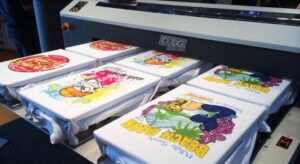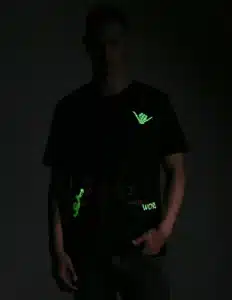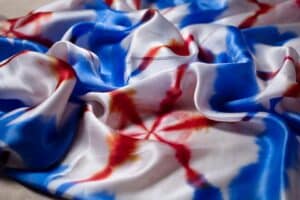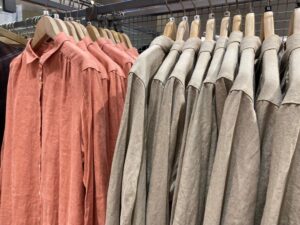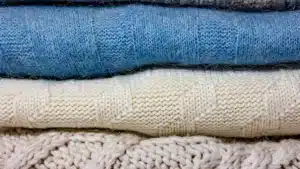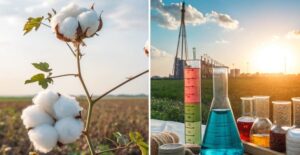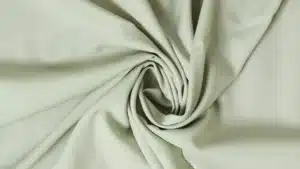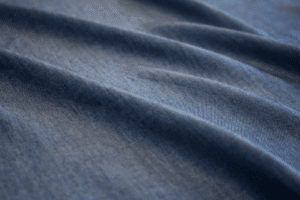RPET stands for recycled polyethylene terephthalate.
Key Takeaways
-
RPET fabric comes from recycled plastic bottles. It cuts plastic waste.
-
Making RPET fabric uses 85% less energy and 90% less water than new polyester. It is better for the planet.
-
Buying RPET clothes supports eco-friendly habits and fights climate change.
-
Big brands like Patagonia and Adidas now use RPET fabric. This shows fashion is becoming greener.
-
Check clothing tags for 'recycled polyester' or 'RPET' to shop eco-friendly.

What is RPET Fabric?
What RPET fabric means and why it matters
rPET fabric is a textile made from recycled plastic, primarily post-consumer PET bottles, reducing waste and lowering the environmental footprint of clothing production.
It offers a sustainable alternative to virgin polyester, making it popular in eco-friendly outdoor clothing, fashion and sportswear.
It is made from recycled plastic items like bottles and packaging. This process turns trash into something useful, helping reduce plastic pollution. RPET fabric is important in clothing because it is eco-friendly.
To make RPET fabric, plastic waste is collected and recycled. The plastic is broken into small pieces, turned into yarn, and woven into fabric. This fabric is then used to make clothes. Using recycled plastic means less need for new polyester, which comes from oil. This saves resources and meets the demand for greener fashion.
RPET fabric is not just for clothes. It is also used in packaging, car interiors, and other products. Its flexibility and eco-friendliness make it popular with both makers and buyers.
Why RPET fabric helps the environment
RPET fabric is better for the planet than regular fabrics. Making it uses much less energy and water than new polyester. For example, it needs 85% less energy and 90% less water. This helps reduce the harm caused by making textiles.
It also helps solve the problem of plastic waste. Recycling bottles into fabric keeps them out of landfills and oceans. This prevents microplastics from harming animals and nature.
Making RPET fabric also creates fewer greenhouse gases. It produces 65% less carbon dioxide than new polyester. This helps fight climate change. Choosing RPET fabric supports recycling and reduces the use of limited resources.
How Is rPET Fabric Made?
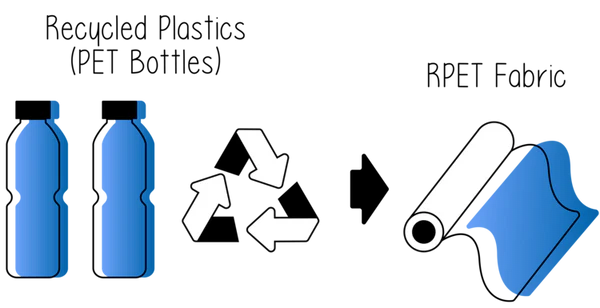
The production of rPET fabric involves several steps that transform discarded plastic bottles into wearable textiles.
Step-by-Step Process of Making rPET Fabric
- Collection & Sorting – Used plastic bottles (mainly PET) are collected and sorted for recycling.
- Cleaning & Shredding – The bottles are cleaned, labels removed, and shredded into small plastic flakes.
- Melting & Extrusion – The flakes are melted and reformed into fine polyester fibers.
- Spinning into Yarn – The fibers are spun into yarn, which is then woven or knitted into fabric.
- Finishing & Dyeing – The fabric is processed, dyed, and prepared for garment production.
This process reduces the need for virgin polyester, conserving resources while repurposing plastic waste.
Buying RPET fabric products helps save resources and cut pollution. Recycling shows how we can make a greener future by reusing old materials.
Properties and Benefits of RPET Fabric
Key properties of RPET fabric
RPET fabric is strong and useful for many things. It is as tough as regular polyester, making it great for clothes. It lasts longer than nylon and viscose, staying strong over time. RPET fabric also doesn’t fade easily in sunlight. This makes it perfect for outdoor clothing and gear.
Another important feature is its eco-friendly nature. Making RPET fabric uses half the energy of new polyester. Using recycled plastic reduces trash and saves resources. These qualities make RPET fabric a green choice for the planet.
Advantages for manufacturers and consumers
RPET fabric helps companies save money and protect nature. It needs less water and energy to make, lowering costs. Businesses can meet recycling rules by using RPET fabric.
Shoppers enjoy durable and stylish items made from RPET fabric. Buying these products helps cut plastic waste and supports recycling. Brands that use RPET fabric show they care about the environment. This attracts buyers who want to make greener choices.
Comparison with traditional polyester
| Property | RPET Fabric | Traditional Polyester |
|---|---|---|
| Durability | Same durability | Good durability |
| Environmental Impact | Much lower | Higher environmental impact |
| Water Consumption | Uses less water | Uses more water |
| Energy Consumption | Uses less energy | Uses more energy |
RPET fabric is better for the Earth than regular polyester. It has a smaller environmental footprint because it’s made from recycled plastic. Both materials are strong, but RPET fabric uses fewer resources. Choosing RPET fabric helps reduce pollution and supports eco-friendly practices.
Environmental Impact of RPET Fabric
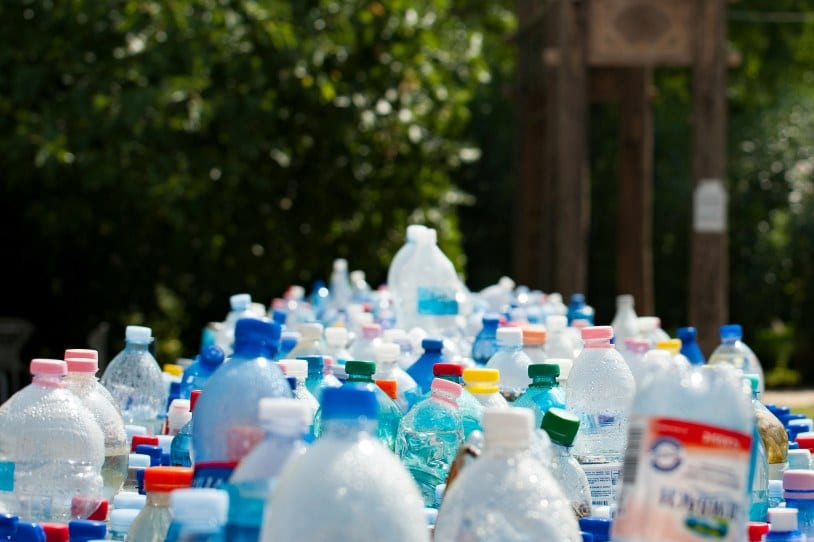
Cutting down plastic waste
Choosing rPET fabric helps reduce plastic trash on Earth. Millions of plastic bottles harm animals and nature every year. Recycling these bottles into fabric gives them a new purpose. This keeps plastic out of oceans and landfills. It also lowers the need for new materials.
Using less energy and cutting emissions
Making rPET fabric uses much less energy than regular polyester. It needs 33-53% less energy and makes 65% fewer emissions. This makes rPET fabric great for fighting climate change.
Choosing rPET fabric lowers the harm caused by making clothes.
Supporting sustainable habits
rPET fabric helps promote eco-friendly habits. It follows the idea of reusing and recycling materials. This is better than the old way of using and throwing away items. People want more eco-friendly products. Supporting rPET fabric brands helps save resources and protect the planet.
Applications of rPET Fabric in Clothing

Use in activewear and sportswear
RPET fabric is great for activewear and sports clothes. It is strong and lasts a long time, even with tough use. The fabric doesn’t wear out easily, so it’s good for workouts. It stays strong when wet, making it perfect for outdoor activities. For example, RPET is four times stronger than nylon and twenty times tougher than viscose. This means sports gear made from RPET will last longer and work better.
Another reason RPET is good for activewear is its eco-friendly design. It uses recycled plastic bottles, which helps reduce waste. This matches the growing need for green materials in sports clothing. From running shorts to yoga pants, RPET fabric combines performance with sustainability.
| Performance Metric | Description |
|---|---|
| Durability | RPET fabric resists wear and tear, almost as good as nylon. |
| Strength and Toughness | Fiber strength ranges from 2.6 to 8.0 cN/dtex, depending on type. |
| Wet Strength | Wet strength is nearly the same as dry strength. |
| Impact Strength | RPET is 4 times tougher than nylon and 20 times tougher than viscose. |
| Environmental Benefits | Made from recycled plastic, it supports eco-friendly activewear. |
Everyday clothing and accessories
RPET fabric isn’t just for sportswear; it’s used in daily clothes too. T-shirts, jackets, and bags are now made from RPET. It is as durable as regular polyester but better for the environment. Unlike cotton, which needs lots of water to grow, RPET reuses plastic waste. This makes it a greener choice for casual wear.
Making RPET fabric uses less water and energy than new polyester. It also reduces the need for oil and cuts down ocean pollution. By buying recycled fabric products, you help keep plastic out of landfills.
Examples of brands using RPET fabric
Many big brands now use RPET fabric for eco-friendly clothing. The fashion industry uses the most recycled RPET because of rising demand. Companies like Patagonia, Adidas, and H&M include RPET in their designs. These brands aim to lower their environmental impact by using recycled materials.
This shows that manufacturers are becoming more eco-conscious. Supporting brands that use RPET helps the planet and encourages sustainable fashion practices.
What Are the Issues With rPET?
Despite its sustainability benefits, rPET fabric has some challenges, particularly regarding environmental concerns and performance limitations.
While rPET reduces plastic waste, it still sheds microplastics and requires chemical-intensive processing. Additionally, its long-term sustainability depends on improvements in recycling technology and infrastructure.
Challenges of rPET Fabric
| Issue | Explanation |
|---|---|
| Microplastic Shedding | Like regular polyester, rPET releases microplastics when washed, contributing to ocean pollution. |
| Energy-Intensive Recycling | Requires chemical processing to break down plastic into fibers. |
| Limited Recycling Cycles | rPET fibers degrade over time, making them difficult to recycle repeatedly. |
| Potential Contamination | PET bottles used for recycling may contain additives that affect fiber quality. |
How to Address These Issues
- Use Washing Filters – Reduce microplastic pollution by using washing machine filters or laundry bags.
- Advance Chemical Recycling – Improve methods to recycle rPET multiple times without fiber degradation.
- Increase Transparency – Ensure brands source rPET from responsible recycling programs.
How to Care for rPET Fabric Clothing
Proper care can extend the lifespan of rPET garments and minimize their environmental impact.
Best Practices for Washing & Maintaining rPET Fabric
| Care Tip | Reason |
|---|---|
| Wash in Cold Water | Preserves fabric quality and reduces energy use. |
| Avoid Harsh Detergents | Chemicals can weaken the fibers over time. |
| Air Dry When Possible | Reduces energy consumption and fabric stress. |
| Wash Less Frequently | Minimizes wear and microplastic release. |
By following these care instructions, wearers can make the most out of their rPET garments while maintaining their sustainability benefits.
FAQ
What does RPET stand for?
RPET means Recycled Polyethylene Terephthalate. It is made by recycling plastic bottles and other PET items. These recycled plastics are turned into fibers. The fibers are used to make eco-friendly fabrics for clothes and other products.
How can you identify clothing made from RPET fabric?
Check tags or labels for "recycled polyester" or "RPET." Many brands highlight their use of sustainable materials. Look for certifications like the Global Recycled Standard (GRS) to ensure it’s genuine.
Is RPET fabric safe for your skin?
Yes, RPET fabric is safe to wear. During recycling, it is cleaned and processed carefully. The final fabric has no harmful chemicals, so it’s good for daily use.
Does RPET fabric release microplastics?
Yes, washing RPET fabric can release tiny plastic pieces into water. To prevent this, use a microfiber-catching laundry bag or wash less often. New fabric technologies can also help reduce this problem.
Why should you choose RPET fabric over traditional polyester?
RPET fabric uses recycled plastics, cutting down waste and saving resources. It takes less energy and water to make, making it better for the planet. Choosing RPET supports eco-friendly habits and helps protect nature.





